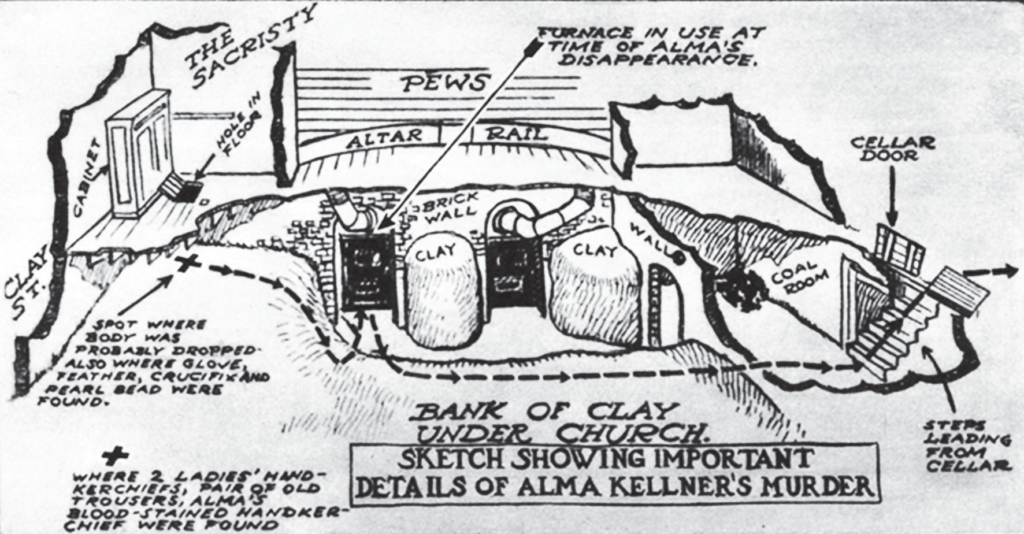
On a bitterly cold day in December 1909, eight-year-old Alma Kellner simply disappeared from the altar of St. John’s Church in Louisville. Her body was found months later near the site of the church, and news of the murder rocked the city. The manhunt for the suspect took Louisville police Captain John Carney eleven thousand miles across the country, and even to South America, to return the killer to justice. The article below draws on Louisville’s Alma Kellner Mystery by Shawn M. Herron, who details the fascinating story of a tragedy that still remains under a cloud of suspicion.
“My Dear Chief: I wish to tender you my heartiest congratulations in running down Wendling. I consider that it was one of the greatest pieces of detective work I have ever known in years, and I am glad of the fact that you are indebted to nothing but your own ability and skill in tracing this clever fugitive to his lair and effecting his capture.

I have watched the papers with deep interest, not only on account of the brutality of the crime, but on account of the skill you displayed in following up Wendling. None of your friends wish you more hearty congratulations than I do. The successful termination of this hard-won, splendid achievement is one that any detective in the world might be proud of. … Starting out on such a trail without much of a clew you certainly are entitled to be congratulated on your success.
With kindest personal regards, I am, sincerely yours, W.A. Pinkerton.”
On August 4th, 1910, Captain John P. Carney of Louisville, Kentucky received this letter from one of the most famous private eyes in the world. Pinkerton’s agency, which we’ve written about in connection with murders in Chisago County, Minnesota and elsewhere, had sent this note alongside plaudits from dozens of other law enforcement bureaus across the country, after a months-long manhunt that crisscrossed the entire United States.

Just who was Joseph Wendling, whom Carney had finally caught all the way west in San Francisco, where Wendling had both adopted a false identity and gone into hiding? Was he guilty of the grisly crime that left eight-year-old Alma Kellner dismembered, burned, and decomposed underneath a Louisville schoolhouse? A native of France, how had Wendling come to live in the United States, and why, in the days following Kellner’s murder, did he suddenly disappear from his Louisville home?
In her book Louisville’s Alma Kellner Mystery, author Shawn M. Herron digs deep into the story of the crime that captivated a city, and that—in the years before television, radio, and the internet—resulted in an international manhunt for a ruthless murderer. After all, Kellner had been abducted from her morning prayers at her local parish, almost out from underneath the eyes of the priest and the congregation. The brazenness of the crime, and the gruesome discovery of her mutilated body months later, not only galvanized her immediate community but spurred a deep desire for justice that ultimately ended in his capture and conviction.

But how did Carney do it? Herron, a seasoned attorney who is no stranger to the courtroom herself, tells the full story in her book, which reads like a thriller as the dragnet closes around Wendling. A crack forensic team, scouring the site for clues. Early chemical analysis, revealing bloodstains on key pieces of evidence. A veteran team of investigators, sifting through thousands of tips, some legitimate, some bogus, to track his movements. And did we mention the decoy letters Carney sent through Wendling’s mistresses, as Wendling wound westward more and more?
Arrested underneath a sink in a San Francisco boardinghouse, Wendling could scarcely have imagined a less dignified coda to his long flight. But to learn how he ended up there in the first place—and what happened once Carney brought him back across the country to Louisville, you’ll have to read Herron’s account. After all, despite his eventual conviction, Wendling maintained his innocence until the end. Suffice to say—for Carney to have received a note from the Pinkertons on their return, well, that’s like earning praise from Sherlock himself!




